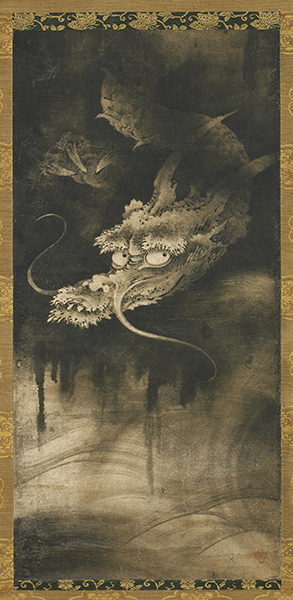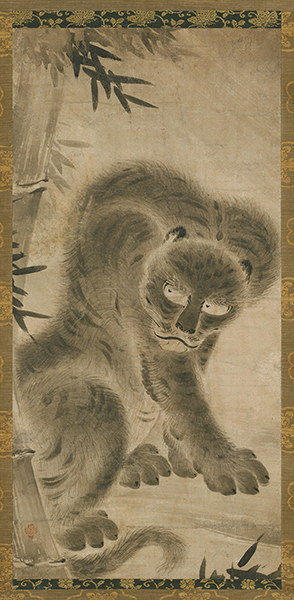Second Leader of the Kanō School: Kanō Motonobu
At the end of this week, August 28, we remember the anniversary of the passing of Kanō Motonobu (1476–1559) of the illustrious Kanō School. Not really a “school,” the Kanō School was a group of artists who shared a similar aesthetic and adopted the Kanō family name. This “fearsome” dragon probably looks the way most of us feel right now with no end in sight to the pandemic. On the other hand, I’ve always found the style of depicting such creatures as dragons, tigers, and lions by traditional Japanese artists to be rather charming.
 |
| Kanō Motonobu, attributed to (1476–1559, Japan), Dragon. Ink and color on paper mounted as a hanging scroll, 33 ¼" x 17 ¼" (84.5 x 43.8 cm). © 2020 Philadelphia Museum of Art. (PMA-2758) |
This monochromatic hanging scroll depicts a fantastical dragon descending from shadowy clouds above a storm-tossed sea. The creator of the painting produced a matching scroll, as well, which shows a crouching tiger. A particularly symbolic animal pair, the dragon and tiger together represented important opposing concepts or elements in the Buddhist religion and Taoist and Confucian philosophies: yin and yang, darkness and light, water and earth, and east and west, being a few examples. The two creatures—both of which the Japanese considered mythical—were subjects imported from China and date back to the first 1000 years BCE.
Motonobu was the son of the founder of the illustrious Kanō School, Masanobu (1434–1530). To understand the importance of the school’s influence on Japanese art, one must understand the period in which it arose, the Muromachi (1392–1573). The Kamakura period in Japan (1185–1333) is named after the samurai (military) clan that established the shogunate, a military dictatorship, that would rule Japan until the mid-1800s. The respected emperor no longer had any real power. The period was wracked with civil wars. The Muromachi period that succeeded it is named after the part of Kyoto from where the shogunal family, the Ashikaga, ruled. The Ashikaga gained control after bringing some sense of order back to Japan. Unfortunately, another major civil war broke out in 1467, which would last another hundred years.
It was during these two difficult periods, which impoverished much of Japan, that Japanese art established the fundamental understandings that characterize Japanese art to the present day: wabi (integrity), sabi (time-tested), and shibui (bitter but refreshing). These represented the Japanese learning to live with difficult times, establishing an aesthetic underpinning to all Japanese arts. The emphasis was on a total harmony between art and nature, the ancient values of respect for ancestors that was part of the Shinto faith and the humility (simplicity) implicit in Zen Buddhism.
The Kanō School of Japanese painting emerged in the 1400s and lasted for more than 300 years. Popular among military patrons, Kanō School artists employed dark ink washes with bold, precise outlines and brushwork. While earlier Kanō works featured little or no pigment, later examples incorporated bright color. Typical Kanō paintings were rendered in large-scale formats and integrated Chinese subjects and themes. The “school” was particularly renowned for the continuation of Chinese-style monochromatic landscape paintings of the Southern Style, the much-lauded landscape aesthetic of the Southern Song Dynasty in China (1127–1279/1280), a period that established the canon that defined the classic Chinese painting style.
Like his father and the subsequent Kanō artists, Motonobu served the Ashikaga shoguns. These artists inherited the Chinese-inspired monochromatic painting style (suiboku-ga, “water-ink painting”), which was favored by the Ashikagas and shoguns of the following Momoyama (1573–1615) and Edo (1615–1868) periods.
Motonobu was also the son-in-law of Tosa Mitsunobu (1434–1525), founder of the Tosa School (again, not a literal school) of painting. That school specialized in the native yamato-e (Japanese Painting) style that had evolved during the Heian period (794–1185), the first period in which Japanese painting flowered. Yamato-e favored bright colors combined with vigorous Chinese brushwork, often on a gold leaf background. Many later Kanō artist adapted the yamato-e style, particularly in large six-fold screen compositions.
Motonobu was brilliant in landscape (both in monochrome and in light color) and also painted figures and bird-and-flower pictures (kacho-e). He painted in the styles of several Song artists, always attributing their influence. These dragon and tiger paintings reflect the soft ink-wash technique of Mu-ch’i (or Muqi, died 1269). He also imitated the hard-edge, linear style of Hsia Kuei (1195–1224) and the “flung ink” style of Yu Chien (active mid-1200s).
 |
| Kanō Motonobu, attributed to, Tiger. Ink and color on paper mounted as a hanging scroll, 33 ¼" x 17 ¼" (84.5 x 43.8 cm). © 2020 Philadelphia Museum of Art. (PMA-2758A) |
In this hanging scroll of a tiger, Motonobu showcases his brilliant talent with brushstroke. Every hair of the tiger's fur is delineated, while the bamboo follows the traditional Chinese calligraphy brush marks in the leaves and the “flung-ink” style of Yu Chien. These early depictions of a single tiger are less "domesticated" than later kitten-like versions in Japanese painting.
Correlations to Davis programs: A Community Connection 2E: 4.5; A Global Pursuit 2E: 7.5; The Visual Experience 3E: 13.5; The Visual Experience 4E: 5.4; Discovering Art History 4E: 4.4


Comments